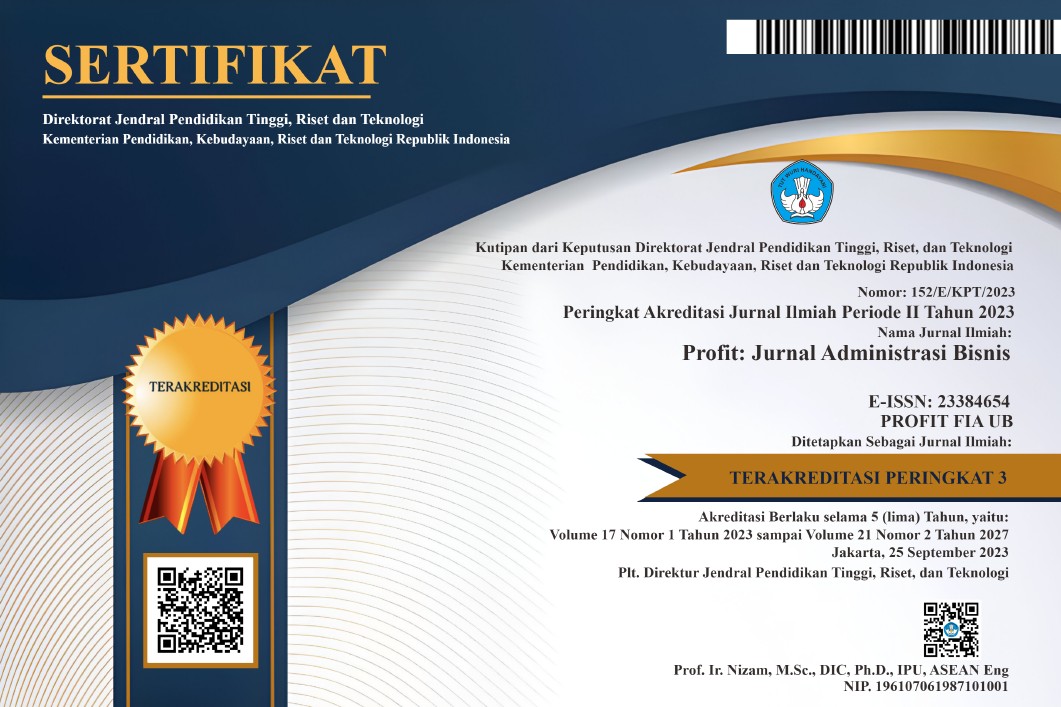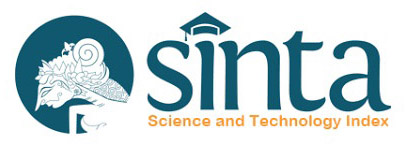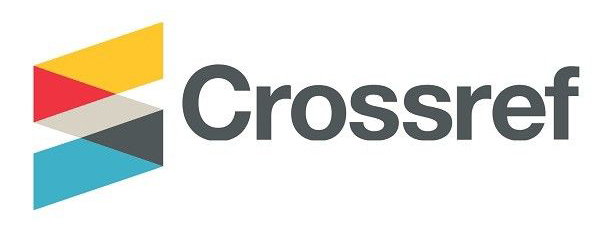PENGARUH CITRA DESTINASI TERHADAP KEPUASAN WISATAWAN DAN BEHAVIORAL INTENTION
DOI:
https://doi.org/10.21776/ub.profit.2021.015.02.7Keywords:
citra destinasi, kepuasan wisatawan, bahavioral intention, pemasaran pariwisataAbstract
This study aims to examine the effect of the destination image variable on tourist satisfaction when visiting and its impact on behavioral intention. This research was conducted at the Nusa Penida tourist destination, Bali, Indonesia. This type of research is an explanatory research with a quantitative approach. The research data was taken directly using a questionnaire to 310 respondents with purposive sampling technique and then analyzed using the PLS model. The results showed that the image of the destination had a positive and significant influence on tourist satisfaction and behavioral intention. Tourist satisfaction also has a positive and significant effect on behavioral intention. The findings of this study strengthen the results of previous research and are in line with the grand theory of S-O-R
References
Aliman, N. K., et al. (2014). "Tourist expectation, perceived quality and destination image: Effects on perceived value and satisfaction of tourists visiting langkawi Island, Malaysia." Asian journal of business and management 2(3).
Allameh, S. et al. 2015. Factors influencing sport tourists’ revisit intentions. Asia Pacific Journal of Marketing and Logistics. Vol. 27 (2) pp. 191-207.
Andreassen TW, Lindestad B. (1998), “Customer Loyalty and Complex Services: The Impact of Corporate Image on Quality, Customer Satisfaction and Loyalty for Customers with Varying Degrees of Service Expertise. International Journal of Service Industri Management, Vol. 9, No. 1, pp.7–23.
Assaker, G., Vinzi, V.E. & O’ Connor, P.O. (2011). Examining the Effect of Novelty Seeking, Satis-faction, and Destination Image on Tourist’ Return Pattern: A Two Factor, Non-Linear Latent Growth Model, Tourism Management, 32 (4), 890-901.
Baker, D.A. and Crompton, J.L.. 2000. Quality, satisfaction and behavioral
intentions. Annals of Tourism Research, 27 (3), PP.785-804
Bitner, M. J. and Hubbert, A. R. 1994. Encounter satisfaction versus overall Satisfaction versus service quality: The consumer’s voice in Rust, R.T. and Oliver, R.L. (Eds), Service Quality: New Directions in Theory and Practice, Sage Publications.
Bigne, J. E., et al. 2001. Tourism image, evaluation variables and after purchase behavior: inter-relationship. Tourism Management. 22 (6): 607-616.
Bruwer, J., & Buller, C. (2017). Product Involvement, Brand Loyalty, and Country of Origin Brand Preferences of Japanese Wine Consumers. Journal of Wine Research, 24(1)
Canny, Ivyanno U. (2013). An empirical investigation of service quality, tourist satisfaction and future behavioral intentions among domestic local tourist at Borobudur Temple. International Journal of trade Economics and Finance, 4(2), hlm. 86-91.
Chen, C.-F. and Tsai, D.2007. How destination image and evaluative factors affect behavioral intentions? Tourism Magement, 36, pp.269-278
Cole, S. T., Crompton, J. L., & Willson, V. L. 2002. An empirical investigation of the relationships between service quality, satisfaction and behavioral intentions among visitors to a wild life refuge. Journal of Leisure Research, 34 (1), pp. 1-24.
Court, B., & Lupton, R. A. (1997). Costumer portfolio development: modelling destination adopters, inactive and rejecters. Journal of Travel research, 36(1), 35-43.
Chung, J.Y. and Petrick, J.F. 2012. Price Fairness of Airline Ancillary Fees: An Attributional Approach. Journal of Travel Research. 52(2) 168–181. Sage Publication. Dar, Laiba, akmal, Anum, and et.al. 2011. Impact of Stress on Employees Job Performance in Business Sector of Pakistan. Global Journal of Management and Business Research Volume 11 Issue 6 Version 1.0 May 2011.
Davis and Newstrom.1985. Human Behavior at Work; Organizational behavior, International Edition, Singapore; Mc Graw Hill Book Company.
Engel, James F. 1995. Perilaku Konsumen. Jilid 1 & 2. Jakarta: Binarupa Aksara.
Gartner, William C. 1996. Tourism Development: Principles, Processes, and Policies. New York: Van Nostrand Reinhold.
Giese and Cote. 2000. Menentukan kepuasan pelanggan. Washington: Washington State University
Huang, Haiyan., et al. 2015. Emerald Insight International Journal of Sports Marketing and Sponsorship. Assessing The Relationships Between Image Congruence, Tourist Satisfaction and Intention to Revisit In Marathon Tourism: the Shanghai International Marathon. Vol. 16 Iss 4 p.50
Irawan, H. 2003. 10 Prinsip Kepuasan Pelanggan. PT Elex Media Komputindo : Jakarta
Ismayanti. 2010. Pengantar Pariwisata. Jakarta: PT Gramedia Widisarana Indonesia.
Jin, N., Lee, S., & Lee, H. (2013). The Effect of Experience Quality on Perceived Value, Satisfaction, Image and Behavioral Intention of Water Park Patrons: New versus Repeat Visitors. International Journal of Tourism Research.
Joynathsing, C. and Ramkissoon, H. (2010). Understanding the Behavioral Intention of European Tourists. Paper for International Research Symposium in Service Management.
Kaplanidou, K., 8c Vogt, C. (2007). Do sporttourism events have a brandcitra? In Proceedings of the 2006 Northeastern Recreation Research Symposium (pp.2-7). Newtown Square, PA: U.S. Forest Service,Northern Research Station.
Kasali, Rhenald, 2004 Pasar Indonesia, Segmenting, Targeting, dan Positioning,
Jakarta, :PT. Gramedia Pustaka Utama.
Kennedy, John E. (2009). Manajemen Event. PT Bhuana Ilmu Populer. Jakarta.
Khuong, M.N. & Tien, B.D. 2017. Factors Influencing Employee loyalty Directly and Indirectly though Job Satisfaction A Study of Banking Sector in Ho Chi Minh City. International Journal of Current Research and Academic Review, Vol. 1, No. 4.
Kozak, M., and M.Rimmington. 2000. Tourist Satisfaction with Mallorca, Spain, as an Off-Season Holiday Destination. Journal of Travel Research, 38: 260-69
Lee, Cheng-Fei and Brian King . 2012. Assesing Destination Competitiveness. An Application to the Hot Springs Touris Sector RTHP 3(3): 179-197.
Machin, D., & Campbell, M.J., (1989), Statistical Tables for The Design of Clinical Trials, London: Blackwell Scientific Publication.
Oliver, R. L. (1980). A Cognitive Model of the Antecedents and Consequences of Satisfaction Decisions. Journal of Marketing Research, Vol. 17, No. 4, 460-469.
Oliver, Riscrd L, (1997), Satisfaction A Behavioral Perspective On The Consumer. McGraw-Hill Education, Singapore.
Paunovic, S., dan Dima, I.C. 2014. Organizational culture and corporate entrepreneurship. Annals of the University of Petroşani, Economics, 14(1), 2014, 269-276
Pitana, I Gede. and Surya Diarta, I Ketut. 2009. Pengantar Ilmu Pariwisata. Gramedia, Jakarta
Peter, J. Paul & Jerry C. Olson. (1999). Consumer Behavior, Perilakukonsumen dan
Strategi Pemasaran.Jilid kedua, Edisi Keempat. Terjemahan Damos Sihombing dan Peter Remy Yossi Pasla. Jakarta: Erlangga.
Prayag. Girish. 2009 . Assessing International Tourist’ Perpections Of Service Quality At Air aurutius. International Journal of Quality & Reliability Management. Vol. 24, No. 5, pp. 492-514.
Prayag, G., Hosany, S., & Odeh, K. (2013). The role of tourists' emotional experiences and satisfaction in understanding behavioral intentions. Journal of Destination Marketing & Management, 118-127.
Ramkissoon, H. (2014). Travelers' E-Purchase Intent of Tourism Products and Services. Journal of Hospitality Marketing & Management, 1-25
R, Basiya and Rozak, Hasan Abdul. 2012. Kualitas Daya Tarik Wisata, Kepuasan, dan Niat Kunjungan Kembali Wisatawan Mancanegara di Jawa tengah. Jurnal Dinamika Kepariwisataan, Vol. XI No.2, p. 1-12
Simamora, Henry. 2006. Manajemen Sumberdaya Manusia. Yogyakarta: Sekolah
Tinggi Ilmu Ekonomi YKPN.
Tang, Mei-Ling. 2014. Tourist Attraction, Satisfaction, and Behavioral Intention of Industrial Tourist: Economic Factors as Moderator. The Journal of International Management Studies, Vol.9 No. 2. August.
Tasci, D.A., and Kozak, M. 2006. Destination Brands vs Destination Images. Do We Know What We Mean?. Journal of Vacation Marketing, Vol 12, No. 4, March: 299-317
Tasci, A. D. A., Gartner, W. C., Cavusgil, S. T. 2007. Conceptualization and Operationalization of Destination Image. Journan of Hospitality & Tourism Research, Vol. 31, No. 2, pp. 194-223.
Tavitiyaman P, Zhang HQ, Qu H. 2013. The effect of competitive strategies and organizational structure on hotel performance. International Journal of Contemporary Hospitality Management. Vol.24. No.1 Hal. 140-159.
Tavitiyaman, Pimtong. 2011.The Impact of Indsutry Forces on Resource Competitive Strategies and Hotel Performance . UMI Dissertation Publishing
Tong, Cheng. (2016). The Influence Of Destination Image and Tourist Satisfaction On Tourist Loyalty: A Case Study Of Chinese Tourists in Korea, Tourism and Hospitality Research, Vol.10 Issue2, pp.223-234
Zeithaml and Bitner. 2003. Service Marketing Inttegrating Customer Focus Across the Firm, 3rd edition. Boston. Mc GrowHill/Irwin.
Zeng, Fue. Hu, Zuohao. Chen, Rong dan Yang, Zhilin. 2015.“Determinants of online service satisfaction and their impacts on behavioural intentionâ€. Total Quality Management. Vol. 20, No. 9, 953-969
Downloads
Published
Issue
Section
License
Copyright (c) 2021 PROFIT: JURNAL ADMINISTRASI BISNIS

This work is licensed under a Creative Commons Attribution-NonCommercial 4.0 International License.
The copyright of the received article shall be assigned to the journal as the publisher of the journal. The intended copyright includes the right to publish the article in various forms (including reprints). The journal maintains the publishing rights to the published articles.

This work is licensed under a
Creative Commons Attribution-NonCommercial 4.0 International License

















